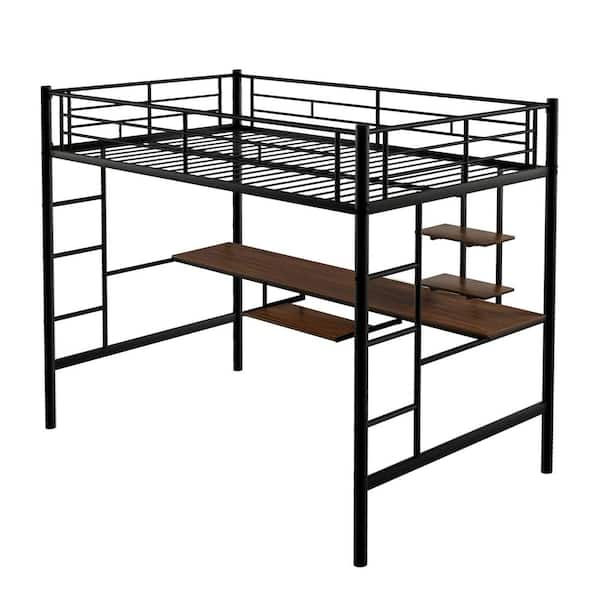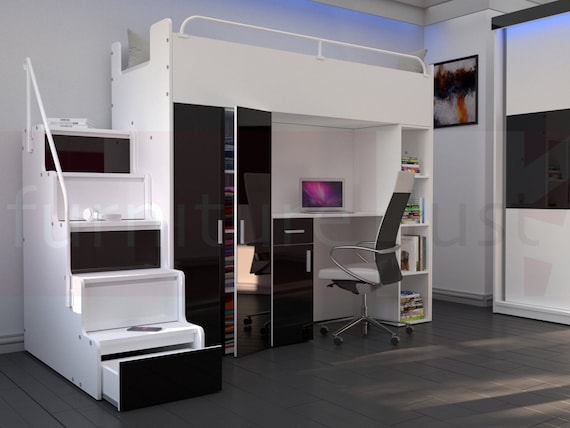20 Top Suggestions For Picking Boys Bed Websites
Wiki Article
Top 10 Tips To Evaluate Safety Features In Bunk Beds And Lofts For Kids
When you are choosing bunk or loft beds, safety should be the top priority. Here are 10 important tips for choosing safety features to ensure that your child is comfortable and safe while sleeping.
1. Guardrails:
Guardrails are a vital safety feature on any loft or bunk bed. You should ensure that there are strong guardrails that are firmly placed on both sides of the loft bed which should extend at least 5 inches over the mattress. This will prevent children from rolling off the mattress while sleeping and also provide a protection when they sit or move about. The inspection of the guardrails is important to ensure they're securely attached and free of damages.
2. Ladder design:
Another important aspect of security is the ladder's design. A ladder with broad, non-slip steps and is secured to the frame of your bed is more safe. Straight ladders are more comfortable to climb with kids than those with steep steps. Look for models with angled ladders, or side rails to help kids hold on when climbing. Also, show your child to use the ladder properly so that they are less susceptible to fall.
3. Bed height:
Height of bed is very important, especially for children under five years old who might lack the coordination or stability to manage an elevated sleeping surface. It is important to select an appropriate bed height for your child. It is safer to choose a lower bed for younger kids, while older children may be able to handle more elevated bed heights. Consider the room ceiling height to ensure you have adequate space above the top bunk.
4. Durable Construction:
It is crucial to think about the quality of materials and construction when selecting a bed. Choose beds that are constructed from high-end materials, such as solid hardwood or steel. Do not choose designs that sway or squeak when you weight them. The bed frame needs to be sturdy and stable so that it can be able to support the weight of the mattress as well as the weight of its people.
5. Corner Posts
Avoid designs with sharp corners or protruding pieces to limit the risk of injury. Sharp edges can lead to accidents. This is particularly true in rooms where kids are playing. A lot of manufacturers offer beds that are smooth and rounded edges that are safe for children who are young.
6. Weight Limits:
Make sure you check the manufacturer's weight limit for top bunk. To avoid structural damage it is essential to adhere to this weight limit. It is essential to inform your children about the limits on weight and discourage roughhousing or jumping on the top bunk.
7. Size of Bedding
It is crucial to choose the right size mattress for security. Make sure that the mattress is fitted snugly to the frame. This will prevent gaps where a child may slip through. A properly fitting mattress will not have more than 4 inches between the mattress and the guardrails. Check the manufacturer's guidelines regarding mattress sizes.
8. Regular Inspections
To ensure safety, frequently inspect the bed for any indications of wear and wear. Examine the bed for any loose bolts or screws. Also, look out for structural damage. Perform these inspections at least every couple of months, and address any issues immediately to keep the bed safe.
9. Age Recommendations
The age requirements for various bunk beds are defined. Follow the instructions from the manufacturer to ensure that the bed you choose is suitable for your child. Certain beds might not be suitable for younger children due to their height or design features that could be a danger.
10. Supervision:
Let children younger than them utilize the top bunk, but with supervision. A supervision program can encourage safe habits like climbing slowly and avoiding the risk of falling or playing rough on the mattress. Informing children about the risks of bunk beds can also help them develop responsible habits.
With these ten safety features, you can pick a bunk bed or loft bed that will not only meet the needs of your child, but also offers a safe sleeping environment. It is essential to place the safety of your child first so that you child can relax in their new bunk bed in peace. View the recommended loft bed for blog examples including childrens bunk beds, loft bunk beds, loft full size bunk bed, loft bed, bed bunk with slide, bed bunk loft, bunk loft, slide on bunk bed, bed on loft, bed bunk loft and more.

Top 10 Tips to Choose the Best Loft Beds or Bunk Beds for Children
Accessibility is an important factor when buying bunk beds and lofts for children. This will ensure the safety, comfort and accessibility. Here are ten important tips to keep in mind when purchasing these bunk beds.
1. Ladder design:
Pick a loft bed or bunk bed that has an attractive ladder. Choose a bed with large, non-slip steps to ensure a safe climb. A ladder that is secured to the bed frame is crucial for stability. The ladder must be angled to facilitate the younger child.
2. The bed must be set in the following manner:
Consider the position of the mattress in the space. Be sure the bed is set in a way that allows easy access to the ladder or stairs from a variety of angles. Be sure to avoid placing the bed against the wall or in a corner where there is restricted access. The layout should support easy entry and exit without causing any dangers.
3. Guardrails:
The top bunk should be equipped with sturdy guardrails to allow for safety and ease of access. Guardrails must extend far enough over the mattress to keep you from falling, but they shouldn't be in the way of the ability to climb into and out of the bed. Choose designs that include guardrails which are easy to maneuver without compromising the security.
4. Bed height:
The height of the bed plays a major role in accessibility. You should consider the bed's height from the floor, and whether or not your child will be able to comfortably reach the top bunk. Lower levels may be more suitable for smaller or younger children to enable them to safely ascend and descend.
5. Alternative Access Options
Some beds are built with an alternative method of access, for instance stairs instead of an actual ladder. Stairs are an easier alternative to ladders for kids younger than five years old and for those who find it difficult to climb up them. To make climbing easier, look for beds that have broad, shallow stairs as well as handrails.
6. Capacity for Weight
It is important to consider the mattress's weight when determining the accessibility. A bed that is able to support all the of the weight (including the child) as well as any other items, such as toys or bedding, is vital. The material must be able to support a certain weight limit but still be stable. This will help when children climb into and out.
7. Clear Pathway
Ensure that there is an easy route between the room and the bedroom, free of obstructions or clutter. A clean, tidy space makes it easier for children to access the bed. Encourage habits of keeping the area around the bed tidy to reduce the risk of tripping or distractions when climbing.
8. Age Appropriateness:
Take into consideration the age and physical capabilities of the child who is using the bed. Younger children may require additional assistance in climbing safely, whereas older children may want more independence. Pick a style that is compatible with the child's capabilities, and ensure they can easily access the bed with no assistance.
9. Supervision:
Encourage younger children to use the loft bed or bunk above their bed. Parents can offer support for children and encourage safe behaviour when they use the stairs or ladders. Making sure children know how to utilize the bed could boost their confidence and help them to be independent.
10. Maintenance and inspection:
Regularly check the bed for any missing parts or wear signs which could hinder access. Verify that the ladder and guardrails are securely attached and working properly. Routine checks can maintain the safety and usability of the beds, giving parents a peace ofmind.
By focusing on these ten suggestions for easy access You can pick an loft or bunk bed that is safe and user-friendly for your child. It is essential to consider accessibility. This will not only improve your child’s comfort, but it also helps to promote the habit of a responsible sleep. Read the recommended bunk bed for more examples including bed and loft, bed on loft, bed for loft, bunk full size bed, loft with bed, childrens bunk beds, bed for loft, twin over full loft bed, full size bed with bunk, full size bunk bed with loft and more.
